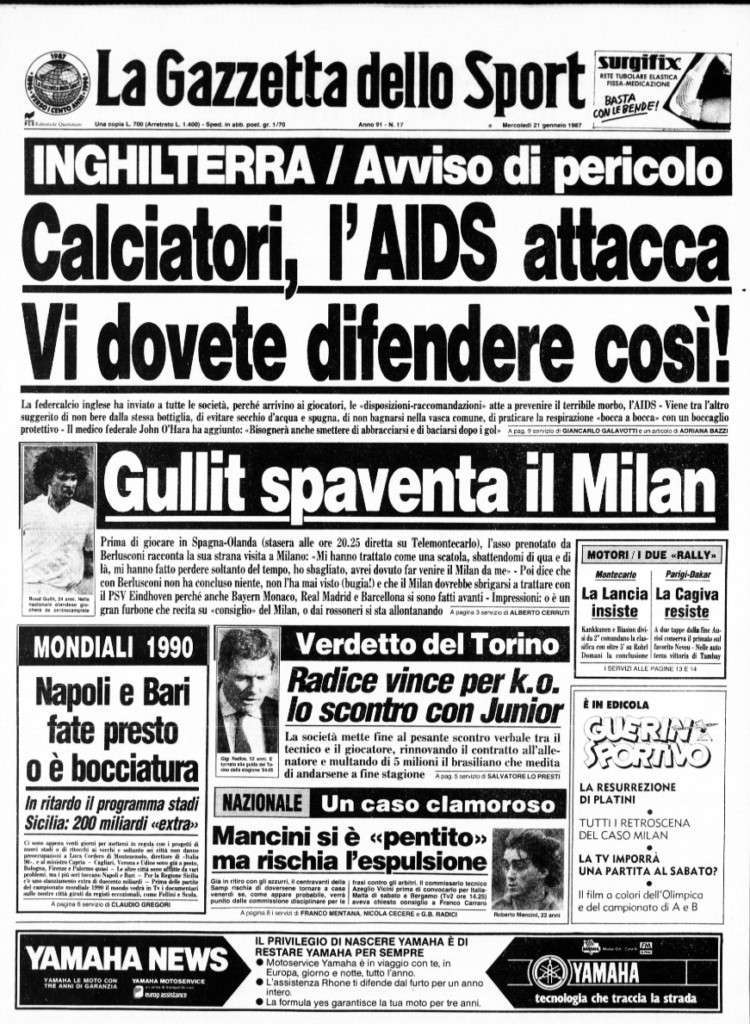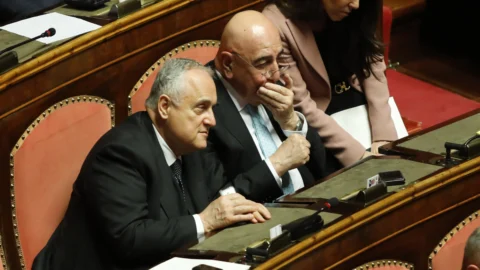Championship yes, championship no. Games with open doors or closed stadiums. Postponements, suspension of tournaments or continue with "normality". Even the football, inevitably, ended up being overwhelmed by the emergency coronavirus these days. Insiders, simple fans, politicians and scientists: all launched into dozens of proposals, hundreds of solutions and thousands of controversies on how the main national sport should coexist with the COVID-19.
It is not the first time that football issues and health problems end up intertwining and the world of football is forced to deal with unpredictable and unknown viral threats. It happened in the eighties of the last century, with the eruption on a planetary scale of theHiv, or the "Human Immunodeficiency Virus", the cause ofaids. With the spread of the disease, world football leaders began to worry about the health of the players and studied some measures to avoid, or at least limit to a minimum, the risk of contagion.
Read today, 35 years later, with the current ones medical knowledge unknown to the scientific community at the time, some hypothesized suggestions for dealing with the HIV risk make you smile, so close to the sense of the ridiculous. Other measures, however, have survived and are still part of thecurrent regulation FIFA Official in force.
"We need to check all Swedish tourists at our airports to make sure they are not carrying AIDS." Thus, in October 1985, the Turkish press headlined on the eve of the meeting valid for the second round of Champions Cup final between Gothenburg and Fenerbahce. The wrath of the media in Istanbul was unleashed by the fact that the local customs officers had meticulously searched three players of the Turkish team at the Swedish town's airport. "Scandal", "Cancel the meeting and go home", "The government protests against the savage incident": these are some passages from the articles published in those days. In short, it was necessary to avenge the insult suffered and give Gothenburg supporters tit-for-tat in view of the return match. Up to the suspicion, in fact, that away infectors could lurk among them.

The first, official and controversial intervention by a prestigious institutional football body on the AIDS issue is dated 1987. On January 20, a hornet's nest of controversy was unleashed by a handbook drawn up by the Football Association, the English Football Federation, in which a series of optional rules were issued for clubs across the Channel with the aim of stem the virus of HIV.
These are the points contained in the decalogue:
1 – On the pitch or during training, don't drink from the same bottle of water or even from the same bottle of champagne to celebrate a win.
2 – Replace the baths in the common tub with the individual shower.
3 - Dress open wounds with sterile gauze and bandages, using surgical gloves.
4 – Avoid using a bucket of water and a sponge for the team: replace them with antiseptic solutions.
5 - If mouth-to-mouth resuscitation is necessary, practice it with a protective mouthpiece.
6 - Avoid using in common with other people: game outfits, toothbrushes, razors, bottles.
7 - Use paper or plastic cups and glasses to throw away once used.
8 – Clean blood-stained clothing and objects immediately.
9 - Put the medical material already used in containers for incineration.
10 - In sexual relations limit yourself to a single partner, use condoms and avoid contact with prostitutes especially in Central and East African countries.
The comment of the federal doctor was direct, John O'Hara: “The time has come to move on to concrete measures. In the past we have tried to gently get players to stop hugging and kissing to celebrate goals. Now we hope to succeed thanks to fear ". The reply from the Professional Footballers' Association was dry: "This is crazy stuff – the words of the secretary Gordon Taylor -. What are they implying? That we have a habit of lingering in the bathtub with teammates or kissing them with tongue in mouth?”.
On 18 November 1987, Fifa officially took the field against the HIV problem. Urged by numerous national federations to study ways to prevent the risk of contagion during matches, the medical commission of the world's top football body came up with the idea of mandatory shin guards. After remembering how the tibia wounds were the most frequent gaming accidents and that the material used to treat them (in particular, the famous sponges) was summary and not sterilised, the medical commission wrote to the Fifa Executive Committee: "As a prophylactic measure against the transmission of AIDS, it is essential that theuse of shin guards you become compulsory”. The first federation to take literally the "recommendation" of the Fifa it was the Swedish one. In June 1988, the Stockholm Football Federation made it compulsory for players of all levels to wear shin guards.
In view of the 1990 World Cup to be disputed in Italy, the norm was made official for everyone. The shin guards, worn for the first time in football in 1874 by Samuel Widdowson, a Nottingham Forest player, ceased to be an optional accessory, they became a mandatory and indispensable element for the protection of the players and were codified in the official rules of the game. The images of Omar Sivori, Gigi Meroni, Mario Corso, Angelo Domenghini, Hans Peter Briegel, Toninho Cerezo or Gianluca Vialli, complete with socks rolled up to the ankles and no "armor" to protect the legs, ceased to be news and became memories historic.





